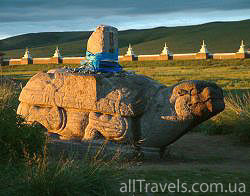–Ъ–∞—А–∞–Ї–Њ—А—Г–Љ |
 –Ъ–∞—А–∞–Ї–Њ—А—Г–Љ (–Љ–Њ–љ–≥. Jara-Horin) вАФ capital of the Mongolian empire; power Karakoruma recognised also governors of Golden Horde. The name goes back to Turkic —В–Њ–њ–Њ–љ–Є–Љ—Г neighbouring mountains Karakorum (literally ¬Ђblack stones¬ї, ¬Ђa heap of black stones¬ї).
–Ъ–∞—А–∞–Ї–Њ—А—Г–Љ (–Љ–Њ–љ–≥. Jara-Horin) вАФ capital of the Mongolian empire; power Karakoruma recognised also governors of Golden Horde. The name goes back to Turkic —В–Њ–њ–Њ–љ–Є–Љ—Г neighbouring mountains Karakorum (literally ¬Ђblack stones¬ї, ¬Ђa heap of black stones¬ї).
It is constructed in 1220 by order of Genghis Khan as the main camp where it left a family for the period of the campaigns and as the centre on manufacture of arms and other equipment of armies. The Chinese advisers have convinced Genghis Khan and its successor Ugedeja (1186вАФ1241) of necessity to have constant capital of the state. During board Ugedeja also there was a representation that –Ъ–∞—А–∞–Ї–Њ—А—Г–Љ вАФ the centre of the Mongolian state. –£–≥—Н–і—Н–є has constructed here a palace named –Т–∞–љ—М–µ–љ—М–≥—Г–љ (a whale.???) вАФ ¬Ђa palace of ten thousand years¬ї. Younger —З–Є–љ–≥–Є–Ј–Є–і–Њ–≤ have obliged to construct too here on a palace.
With a gain Mongols of China and the basis —О–∞–љ—М—Б–Ї–Њ–є dynasties the capital of the Mongolian empire has been transferred to 1267 by khan Hubilaem in –•–∞–љ–±–∞–ї—Л–Ї (nowadays Beijing). After exile of Mongols from China in 1368 the rests —О–∞–љ—М—Б–Ї–Њ–≥–Њ managements have again located in –Ъ–∞—А–∞–Ї–Њ—А—Г–Љ–µ, but for a short while: in 1388 the Minsk armies have completely destroyed a city and after that it has been never restored.
City ruins are in headwaters of the river Orkhon in 380 kilometres jugo-to the west modern Ulan Bator. On aerial photographs ruins of city walls, a lay-out of streets and the rests of a stone laying on which it is possible to define an arrangement of constructions are clearly visible. –Ъ–∞–Ї–∞–Ї–Њ—А—Г–Љ has existed about 140 years. Some times in a city there was the strongest fire and many times it was smashed by armies of the Chinese dynasty of Minute city Ruins there is now near monastery Erdeni-Dzu.
In days of great khans of the Mongolian empire Ugedeja, –Ъ—Г—О–Ї–∞ and Munch in –Ъ there came to a sign on humility and honouring sovereigns of the near and far countries, including Russian of princes; here questions about –њ—А–µ—Б—В–Њ–ї–Њ–љ–∞—Б–ї–µ–і–Є–Є were solved; here decisions on the new aggressive campaigns, millions people putting in action and destinies overturning them were made; here with hope of influence emissaries Muslim, –±—Г–і–і–Є—Б—В—Б–Ї–Њ–є, Christian and other faiths directed. Data about –Ъ contain in the Chinese annals and notes of the European travellers 13 century: –Я–ї–∞–љ–Њ –Ъ–∞—А–њ–Є–љ–Є, Marco Polo and V.Rubruka. It was noticed, that the city consisted of the several quarters isolated from each other in which there lived handicraftsmen, dealers and envoys from all light. There there lived people of different races and religions. Near to Christian (–љ–µ—Б—В–Њ—А–Є–∞–љ—Б–Ї–Є–Љ–Є) —Ж–µ—А–Ї–≤–∞–Љ–Є travellers saw numerous Muslim mosques and Buddhist temples.
Opening history
In the end of 19 century the Russian scientist –Э. M.Jadrintsev surveyed ruins –Ъ–∞—А–∞–Ї–Њ—А—Г–Љ–∞. And. M.Pozdneev has confirmed with the analysis of historical sources site –Ъ–∞—А–∞–Ї–Њ—А—Г–Љ–∞ at Buddhist monastery –≠—А–і—Н–љ–Є–і–Ј—Г (it is constructed in 1585 in southern part –Ъ–∞—А–∞–Ї–Њ—А—Г–Љ–∞).
In 1948 and 1949 the Soviet-Mongolian archaeological expedition here worked. Its head With. V.Kiselyov (1905вАФ1962) has been awarded for this work of a rank of member-correspondent –Р–Э the USSR and the State award of the USSR. In a southwest part of a city the rests of palace –£–≥–µ–і–µ—П built on a granite socle are opened; under a palace the rests Buddhist –Ї—Г–Љ–Є—А–љ–Є the end XII вАФ the beginnings of XIII centuries with a wall list are found out.